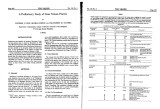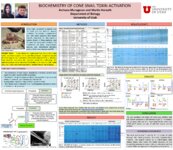|
|
Creator | Title | Description | Subject | Date |
| 176 |
 |
Olivera, Baldomero M. | Preliminary study of Conus venom protein | ALTHOUGH THE TOXICITY of venoms of the genus Conus has been known since a report by RUMPHIUS in 1705 (VAN BENTHEM-JUTTINO, 1959), these venoms have been studied only intermittently since. Biochemical studies have not been carried out to any great extent; the last major study on the biochemistry of... | Conotoxins; Conus venom | 1976 |
| 177 |
 |
Capecchi, Mario R. | Introduction: the molecular genetic analysis of mouse development | This paper is an introduction of seven different papers presented in "Seminars in developmental biology" on Molecular Genetic Analysis of Mouse Development . The first paper, by Janet Rossant, describes very early mouse development. The second paper, by Frank Conlon and Rosa Beddington provide an i... | Embryo Culture Techniques; Genes | 1995-04 |
| 178 |
 |
Clayton, Dale H. | Reciprocal natural selection on host-parasite phenotypes | Coevolution is evolution in one species in response to selection imposed by a second species, followed by evolution in the second species in response to reciprocal selection imposed by the first species. Although reciprocal selection is a prerequisite of coevolution, it has seldom been documented in... | Host-parasite phenotypes; Ectoparasites; Virulence; Fitness | 1999 |
| 179 |
 |
Capecchi, Mario R. | Mice with enhanced macrophage angiotensin-converting enzyme are resistant to melanoma | Angiotensin-converting enzyne (ACE) is a pepitdase responsible for the cleavage of angiotensin I and Several other peptides. Here, gene targeting was used to switch control of the ACE locus from the endogenous promoter to the macrophage-specific c-fms promoter. Challenge of these mice, called ACE 10... | Macrophage enzyme; Melanoma resistance; Enhanced macrophage angiotensin-converting enzyme | 2007 |
| 180 |
 |
Davidson, Diane W. | Species diversity and community organization in desert seed-eating ants | Patterns of species diversity and community organization in desert seed-eating ants were studied in 10 habitats on a longitudinal gradient of increasing rainfall extending from southeastern California, through southern Arizona, and into southwestern New Mexico. Local communities of harvester ants... | Ants; Arizona; California; Communities; Competition; Desert Granivores; Diversity; Insects; New Mexico; Novomessor; Pheidole; Pogonomyrmex; Resource allocation; Veromessor. | 1977 |
| 181 |
 |
Carrier, David R. | Human flight and exercise in microgravity | Early experimenters in human flight learned, sometimes with fatal consequences, that the human body lacks the muscular power to fly (1). Indeed, the power demands are so great that only relatively small animals (less than 12 kg) are able to fly actively due to the interplay of morphologic scaling (m... | Human flight; Microgravity | 2000 |
| 182 |
 |
Potts, Wayne K. | Consequences of self and foreign superantigen interaction with specific VB elements of the murine TCR aB | The aB T-cell receptor (TCRaB) recognizes a ligand composed of an antigen fragment complexed with a product of the major histocompatibility complex (MHC). The repertoire of receptors is limited both by the germ line of receptor variable elements and by selective events that take place during T-cell ... | Toxins; Repertoire; Expression | 1989 |
| 183 |
 |
Davidson, Diane W. | Ant-plant symbioses in Africa and the neotropics : history, biogeography and diversity | Symbiotic ant-plant relationships afford an excellent opportunity to analyze the effects of both historical and ecological factors on the evolution of mutualisms. Occurring in tropical forests throughout the world, all myrmecophytic plants provide food and permanent housing to ants; the ants, in t... | Ant-plant symbiosis; Africa; Neotropics; Myrmecophytes; Plant-ants | 1993 |
| 184 |
 |
Shapiro, Michael D. | Divergence, convergence, and the ancestry of feral populations in the domestic rock pigeon | Domestic pigeons are spectacularly diverse and exhibit variation in more traits than any other bird species [1]. In The Origin of Species, Charles Darwin repeatedly calls attention to the striking variation among domestic pigeon breeds - generated by thousands of years of artificial selection on a s... | | 2010 |
| 185 |
 |
Coley, Phyllis D. | Tritrophic interactions in tropical versus temperate communities | The latitudinal gradient in diversity is one of the oldest (e.g., Wallace, 1878) and most obvious trends in ecology, and a wealth of literature is devoted to understanding both the causes and consequences of this gradient (Dobzhansky, 1950; also reviewed by Rohde, 1992). Given the enormous latitudi... | Tritrophic interactions; Trophic cascades; Herbivory; Tropical communities; Temperate communities | 2002 |
| 186 |
 |
Capecchi, Mario R. | Detection of targeted GFP-Hox gene fuogenesissions during mouse embry. | The ability to use a vital cell marker to study mouse embryogenesis will open new avenues of experimental research. Recently, the use of transgenic mice, containing multiple copies of the jellyfish gene encoding the green fluorescent protein (GFP), has begun to realize this potential. Here, we show ... | Chimera; Crosses, Genetic; Gestational Age; Green Fluorescent Proteins; Mice, Inbred C57BL; Phenotype | 1998-10-27 |
| 187 |
 |
Olivera, Baldomero M.; McIntosh, J. Michael; Gray, William Robert; Hillyard, David R. | New family of conotoxins that block voltage-gated sodium channels | Conus peptides, including ω-conotoxins and α-conotoxins (targeting calcium channels and nicotinic acetylcholine receptors, respectively) have been useful ligands in neuroscience. In this report, we describe a new family of sodium channel ligands, the μO-conotoxins. | Conotoxins; Sodium channel blockers | 1995 |
| 188 |
 |
Capecchi, Mario R.; Mansour, Suzanne L.; Thomas, Kirk R. | Disruption of the proto-oncogene int-2 in mouse embryo-derived stem cells: a general strategy for targeting mutations to non-selectable genes. | Gene targeting--homologous recombination of DNA sequences residing in the chromosome with newly introduced DNA sequences--in mouse embryo-derived stem cells promises to provide a means to generate mice of any desired genotype. We describe a positive nd negative selection procedure that enriches 2,00... | Animals; Clone Cells; Restriction Mapping; Stem Cells | 1988-11-24 |
| 189 |
 |
Horvath, Martin P. | Biochemistry of Cone Snail toxin activation | Cone snails use venom to capture prey for food and for defense against predators. The venom is composed of over 100 active peptides that target specific receptors in the nervous system. Several of these peptides have the potential to become medicine for treatment of pain, depression, seizures, and n... | biochemistry; horvath; olivera; cone snail; toxin; nmda; elution; buffers; sparse matrix test; protease; protein; purification; neurotoxin; conotoxin | 2013 |
| 190 |
 |
Robison, Reid Justin | Whole Exome Sequencing Reveals the Genetic Basis of a Case of Idiopathic Hemolytic Anemia and Suggests Candidate Rare Variants for ADHD in a Utah Pedigree | | | 2011 |
| 191 |
 |
Davidson, Diane W. | Cecropia and its biotic defenses | In all the world, the genus Cecropia is unrivaled for the number of myrmecophytes, or true "antplants" counted among its species (McKey & Davidson, 1993). Based on the proportion of Cecropia species producing Mullerian bodies in at least some parts of their distribution, myrmecophytes comprise the ... | Myrmecophytes; Mullerian bodies; Pearl bodies | 2005 |
| 192 |
 |
Gesteland, Raymond F.; Weiss, Robert B. | Efficient shine- Dalgarno sequence but not translation is necessary for LacZ mRNA stability in Escherichia coli | The 5' ends of many bacterial transcripts are important in determining mRNA stability. A series of Shine-Dalgarno (SD) sequence changes showed that the complementarity of the SD sequence to the anti-SD sequence of 16S rRNA correlates with lacZ mRNA stability in Escherichia coli. Several initiation c... | Protein Biosynthesis; Ribosomes; Escherichia coli; Shine-Dalgarno Sequence | 1994 |
| 193 |
 |
Clayton, Dale H. | Common grackle anting with lime fruit and its effect on ectoparasites | Anting is stereotyped behavior in which birds ex- pose themselves to fluid-secreting ants or other pun- gent substances. During "active" anting a bird crush- es an ant in the bill and rubs it frenetically through its plumage (Rothschild and Clay 1952). During "passive" anting a bird entices ants to ... | Quiscalus quiscala; Columbicola columbae; Anting; Ectoparasites | 1993 |
| 194 |
 |
Coley, Phyllis D. | New cytotoxic cinnamic acid derivatives from leaves of Bonamia trichantha | Bioassay-guided fractionation of the methanolic extract of the young leaves of Bonamia trichantha led to the isolation of four new cinnamic acid derivatives trichanthins A-D (l-4).Their structures were established by spectroscopic methods. All compounds were tested in cytotoxic assays against the MC... | Bonamia trichantha; Cinnamic acid; Caffeic acid ester; p-Coumaric acid ester: Farnesol; Z-(l l)-hexadecen-l-ol; Cytotoxicity | 2006 |
| 195 |
 |
Sperry, John S. | Water transport in vesselless angiosperms: conducting efficiency and cavitation safety | Two structure-function hypotheses were tested for vesselless angiosperm wood. First, vesselless angiosperm wood should have much higher flow resistance than conifer wood because angiosperm tracheids lack low-resistance torus-margo pits. Second, vesselless wood ought to be exceptionally safe from cav... | | 2007 |
| 196 |
 |
Capecchi, Mario R.; Bernstein, Kenneth E.; Thomas, Kirk R. | Targeting genes for self-excision in the germ line | A procedure is described that directs the self-induced deletion of DNA sequences as they pass through the male germ line of mice. The testes-specific promoter from the angiotensin-converting enzyme gene was used to drive expression of the Cre-recombinase gene. Cre was linked to the selectable marker... | Cre-recombinase; Hoxa3; Chimeric mice | 1999-06-15 |
| 197 |
 |
Goller, Franz | Vocal gestures of shared syllable types in cardinals | In songbirds, songs are learned by memorization and copying of tutor song and such copies can be remarkably accurate. However, it is not known whether acoustic similarity is generated by equally similar vocal gestures. We studied syringeal and respiratory motor patterns of syllable types shared by u... | Cardinalis cardinalis; Vocal gestures; Birdsong syllables; Song syllables | 1997 |
| 198 |
 |
Capecchi, Mario R. | Polypeptide chain termination in vitro: isolation of a release factor. | The growing polypeptide chain remains bound to the ribosome-messenger RNA complex through the sRNA carrying the last amino acid incorporated into the polypeptide chain.' On completion of the polypeptide chain a mechanism must exist for releasing it from the protein-synthesizing machinery. To date, m... | Carbon Isotopes; Phenylalanine; Proteins | 1967-09-01 |
| 199 |
 |
Carrier, David R. | Coupled evolution of breathing and locomotion as a game of leapfrog | Because the increase in metabolic rate related to locomotor activity places demands on the cardiorespiratory apparatus, it is not surprising that the evolution of breathing and of locomotion are coupled. As the respiratory faculty becomes more refined, increasingly aerobic life strategies can be exp... | Evolution; Coupled evolution; Breathing; Locomotion; Cardiorespiratory apparatus | 2006 |
| 200 |
 |
Clayton, Dale H. | Feather-busting bacteria | I ONCE HAD A COLLEAGUE who delighted in the aphorism, which he proudly coined himself, "If it's too small to see with the naked eye, it ain't there." Sadly, this view may as well be true for ornithologists who study birds only through unaided eyes, binoculars, or spotting scopes. But birds can also ... | Columba livia; Columbiformes; Ectoparasites; Bacteria; Plumage | 1999 |

























